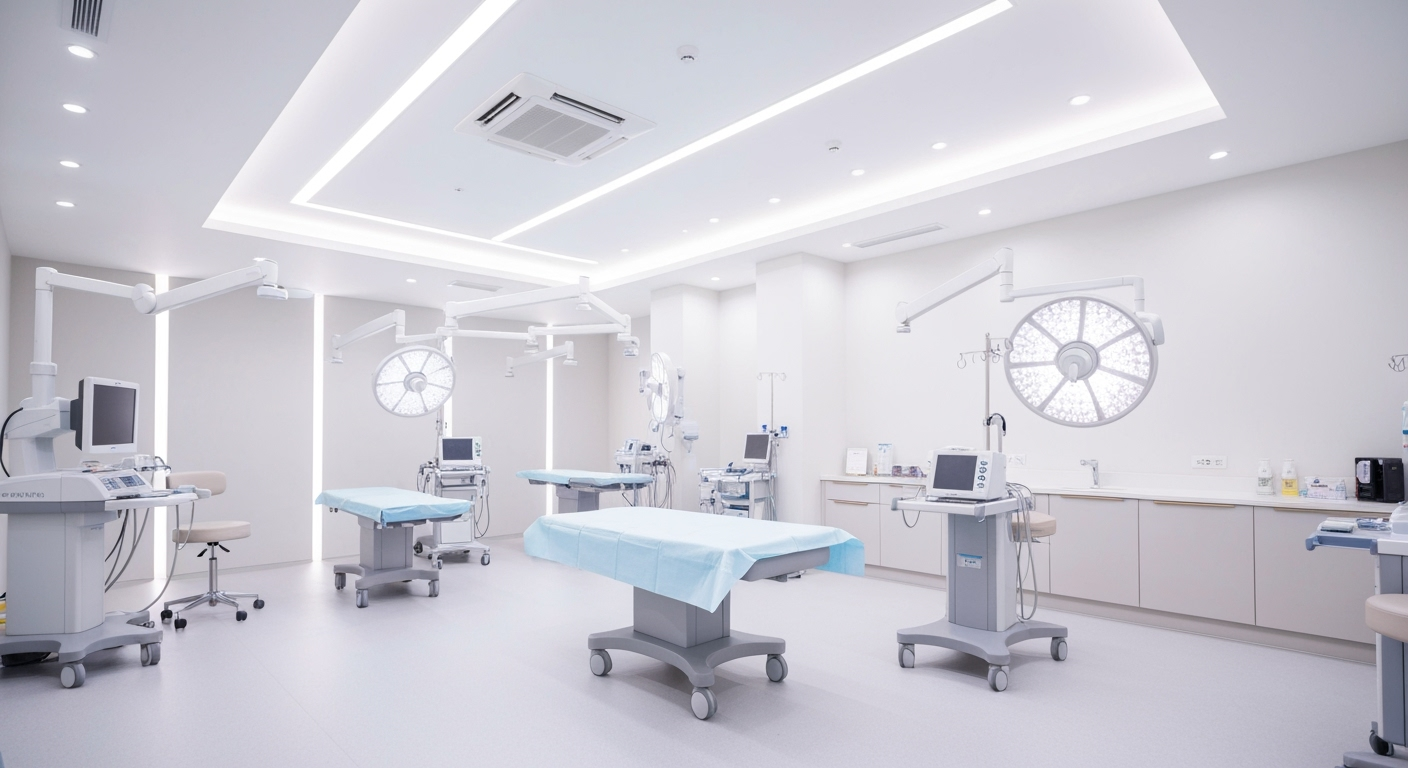Recognizing the Right Time to Address Female Infertility: Key Indicators and Expert Care in Queens

Introducing vNOTES: The Future of Scarless Hysterectomy
Scarless hysterectomy using vaginal natural orifice transluminal endoscopic surgery (vNOTES) is emerging as a revolutionary minimally invasive surgical technique. Combining the benefits of vaginal and endoscopic surgery, vNOTES facilitates uterus removal without external abdominal incisions, providing significant advantages in patient recovery, safety, and cosmetic outcomes. This article delves into statistical evidence, adoption trends, recovery profiles, patient outcomes, and clinical research validating the growing use and efficacy of vNOTES in gynecological surgery.
Understanding Scarless Hysterectomy with vNOTES Technique

What is a scarless hysterectomy using vNOTES technique?
A scarless hysterectomy employing vNOTES (vaginal natural orifice transluminal endoscopic surgery) is a minimally invasive surgical method that removes the uterus without leaving external scars. This technique involves creating a small entry point inside the vaginal canal to access the pelvic cavity. Through this opening, specialized endoscopic instruments and a camera are inserted, providing high-definition visualization for precise dissection.
How vNOTES avoids external scars
Unlike traditional abdominal or laparoscopic surgeries that require small incisions on the abdomen, vNOTES utilizes the natural orifice of the vagina to access the uterus. This means there are no external cuts or scars visible on the abdomen post-surgery. Patients benefit from better cosmetic outcomes, reduced postoperative pain, and faster recovery times.
Technical aspects combining vaginal and endoscopic methods
vNOTES integrates the principles of vaginal hysterectomy with advanced endoscopic technology. Surgeons insert the endoscope through the vaginal opening, establishing a pathway to the pelvic organs. Using high-definition cameras, they carefully dissect and detach the uterus from surrounding tissues. This combination allows enhanced visibility and precision, facilitating easier removal of even larger uteri and complex cases.
Suitability and patient candidacy for vNOTES
Most women scheduled for benign hysterectomies are good candidates for vNOTES, including those with enlarged uteri or previous pelvic surgeries. However, it is not suitable for patients who cannot undergo anesthesia, have active infections, cancers, or complex pelvic conditions. Preoperative assessment ensures appropriate selection, maximizing safety and effectiveness.
In summary, vNOTES offers a safe, effective, and cosmetically favorable alternative to traditional hysterectomy methods, combining minimally invasive access through the vagina with the advantages of endoscopic visualization.
Clinical Evidence on Safety and Complication Rates of vNOTES
 What are the safety and complication rates associated with vNOTES hysterectomy?
What are the safety and complication rates associated with vNOTES hysterectomy?
vNOTES hysterectomy is considered a safe surgical approach, with a complication profile comparable to other minimally invasive routes. A large series reports an intraoperative complication rate of roughly 3.2%, with intraoperative injuries, most commonly cystotomies, accounting for about 1.39% of cases. These bladder injuries are among the most frequent intraoperative issues but are generally manageable.
Postoperative complications are relatively rare, occurring in approximately 2.5% of cases. Common postoperative issues include bleeding, urinary tract infections, and wound or vault problems. Importantly, these complication rates are influenced by factors like patient BMI, uterine size, and prior surgical history, with experience playing a role in minimizing risks.
As surgeons gain more experience with vNOTES, the rates of complications typically decrease. The procedure’s safety profile remains favorable, and the overall risk of severe adverse events is low. Studies assessing the safety of vNOTES in benign indications confirm its feasibility, with low conversion rates to open surgery and minimal severe complications.
This evidence supports the expanding adoption of vNOTES, especially as ongoing training and patient selection improve procedural outcomes. Consequently, vNOTES provides a safe alternative to traditional hysterectomy methods, aligning with the goals of minimally invasive surgery to reduce complications and promote quick recovery.
Comparative Recovery Times: vNOTES vs. Traditional Methods

How does the recovery time of vNOTES hysterectomy compare to other hysterectomy methods?
The recovery time for vNOTES hysterectomy tends to be quicker than that of traditional surgical approaches such as abdominal hysterectomy. Patients who undergo vNOTES typically experience a median time to return of bowel function, indicated by first anal exhaust, around 48 hours, which is notably shorter than the 69 hours observed in laparoscopic hysterectomy.
Moreover, patients returning to work after vNOTES report a shorter median duration—about 2 months—compared to 3 months following laparoscopy. This reduction in recovery time is supported by data from Kaplan-Meier analyses showing faster resumption of normal activities in vNOTES patients.
Additionally, vNOTES is associated with shorter hospital stays and less postoperative pain, contributing to improved comfort and faster overall recovery. Surgical times are shorter—median 90 minutes versus 135 minutes in laparoscopic procedures—and blood loss is lower, further aiding quicker convalescence.
In essence, the minimally invasive nature of vNOTES, combining vaginal access with endoscopic techniques, results in a faster return to everyday life, often within about three to four weeks, with many patients feeling well enough to resume normal activities sooner than those undergoing more invasive surgeries.
This lighter recovery burden makes vNOTES an attractive option for women seeking a less disruptive hysterectomy experience, with studies showing a significant advantage over traditional methods for early intestinal function recovery and rapid return to work.
Statistical Benefits and Advantages Demonstrated by vNOTES
What are the benefits and advantages of vNOTES supported by clinical and statistical evidence?
vNOTES, or vaginal natural orifice transluminal endoscopic surgery, has been shown through numerous studies to offer significant advantages over traditional hysterectomy methods like laparoscopy. Clinical data consistently demonstrate that vNOTES results in shorter operative times, with median durations around 90 minutes compared to 135 minutes for laparoscopic procedures. Moreover, blood loss during vNOTES surgeries is notably less, roughly 100 mL versus 200 mL in laparoscopic hysterectomies.
Hospitalization length and recovery times also favor vNOTES. Patients typically experience a shorter hospital stay and return to daily activities faster, with median return-to-work times of about 2 months, compared to 3 months after laparoscopy. Importantly, faster recovery of bowel function—indicated by an earlier first anal exhaust—further underscores its benefits; the median time to first anal exhaust was 48 hours in vNOTES versus 69 hours in laparoscopic procedures.
These advantages are supported by robust statistical analyses, including linear regression and Kaplan-Meier curves, which confirm the shorter times to functional recovery and return to work in vNOTES groups. For instance, the Kaplan-Meier analysis shows a significantly reduced median time to first anal exhaust and quicker return to employment. Multivariate Cox regression analyses indicate that both surgical approach and postoperative hospitalization significantly influence recovery timelines.
In terms of safety, the complication rates for vNOTES are comparable to or lower than those for traditional methods, with no need for conversion to open surgery in large case series. Its minimally invasive design also results in better cosmetic outcomes and less postoperative pain, enhancing patient satisfaction.
In summary, extensive clinical research substantiates vNOTES as a safe, efficient, and patient-friendly approach. Its proven ability to shorten operative times, lower blood loss, reduce hospital stays, and expedite recovery makes it a compelling option for hysterectomy, even in complex cases such as large uteri or patients with prior pelvic surgeries. Continued research and adoption are expected to solidify its role within gynecologic surgical practice, providing women with a less invasive and more comfortable surgical experience.
Adoption Trends: Rising Popularity of vNOTES in Gynecology

What are the current trends in adoption and popularity of vNOTES within gynecology?
The use of vNOTES (vaginal natural orifice transluminal endoscopic surgery) in gynecology is experiencing a notable increase. As a minimally invasive technique, vNOTES offers significant benefits including shorter operative times, faster recovery, reduced postoperative pain, and no external scars.
Recent data from specialized medical centers reveal a dramatic rise in vaginal hysterectomies performed via vNOTES. For instance, one tertiary center reported an increase from 40.1% of hysterectomies being done vaginally before to over 94% following the adoption of vNOTES tech. This shift indicates a growing preference for less invasive options among both surgeons and patients.
Moreover, vNOTES has been shown to shorten hospital stays and reduce time to first intestinal activity (first anal exhaust), which directly correlates with quicker overall recovery. Although some challenges, such as slightly increased intraoperative blood loss and a low rate of conversions to laparotomy mainly due to adhesions, exist, they are manageable with proper preoperative assessment and surgical expertise.
Training programs and institutional advocacy are playing a vital role in increasing surgeon familiarity and confidence with vNOTES. As more practitioners acquire skills in this technique, its adoption is expected to expand further across various regions.
In summary, the trend toward vNOTES reflects a broader movement toward minimally invasive gynecological surgeries, driven by continuous research, technological improvements, and a focus on patient-centered outcomes. This momentum suggests that vNOTES will play an increasingly prominent role in gynecologic surgical practices globally.
Surgical Outcomes: Operation Time and Blood Loss Analysis
How do median operation times compare between vNOTES and LAVH?
The study shows that vNOTES hysterectomy usually takes less time than laparoscopic-assisted vaginal hysterectomy (LAVH). Specifically, the median operation time for vNOTES was around 90 minutes, whereas LAVH took approximately 135 minutes.
This shorter duration makes vNOTES a more efficient option, particularly beneficial for reducing anesthesia exposure and operating room occupancy.
What are the differences in estimated blood loss?
Patients undergoing vNOTES experienced significantly less blood loss during surgery. The average blood loss was about 100 mL for vNOTES, compared to 200 mL for LAVH.
Reduced blood loss not only minimizes the risk of anemia but also indicates a potentially safer surgical procedure with fewer intraoperative complications.
Does robotic assistance affect surgery duration and blood loss?
Robotic assistance in vNOTES procedures tends to be associated with longer operation times compared to conventional approaches, although it does not significantly change blood loss quantities.
The robotic procedures often involve more setup and docking time, which extends the overall length of surgery but maintains similar blood loss levels to conventional methods.
What factors predict variations in operative time?
Beyond surgical approach, several patient and surgical factors influence operative duration. Body mass index (BMI), uterine weight, history of vaginal delivery, and previous abdominal surgeries were identified as significant predictors.
Understanding these variables helps tailor surgical planning, aiming for safer, quicker procedures with better outcomes.
| Comparison Parameter | vNOTES Outcomes | LAVH Outcomes | Additional Notes |
|---|---|---|---|
| Median Operation Time | 90 minutes | 135 minutes | Robotic assistance can increase duration; conventional is faster |
| Estimated Blood Loss | 100 mL | 200 mL | Minimal blood loss with vNOTES noted as beneficial |
| Uterine Size | Smaller (340 g) | Larger (388 g) | Size impacts ease and duration of surgery |
| Conversion Rate | 0% | 0% | Both approaches showed high safety with no conversions |
Overall, vNOTES offers shorter operation times and less blood loss, with patient-specific factors playing a role in surgical duration. These improvements support its growing use as a safe, efficient alternative to traditional laparoscopic methods.
Postoperative Intestinal Function and Impact on Recovery
How does vNOTES hysterectomy affect the time to first anal exhaust compared to laparoscopic hysterectomy?
Patients who undergo vNOTES hysterectomy tend to recover gastrointestinal functions faster than those who have traditional laparoscopic procedures. In a recent study, the median time to first anal exhaust—a key indicator of bowel recovery—was significantly shorter in the vNOTES group, at 48 hours, compared to 69 hours for the laparoscopic group.
This difference suggests that vNOTES facilitates quicker return of normal intestinal activity, helping patients move towards full recovery sooner.
What is the correlation between early intestinal recovery and other hospital recovery milestones?
Faster recovery of bowel function is closely linked to shorter hospital stays and quicker overall recuperation. The same study reported that patients in the vNOTES group were able to return to their daily activities, including work, about one month earlier than those in the traditional laparoscopy group.
Early bowel function resumption can reduce complications related to delayed gastrointestinal mobility, such as discomfort, bloating, or nausea, leading to improved patient well-being.
How do the statistical findings support these recovery advantages?
The differences in intestinal recovery were statistically significant, with a p-value less than 0.001, indicating a very reliable difference between the two surgical methods. Kaplan-Meier curves also visually demonstrated that patients in the vNOTES group experienced a shorter median time to first anal exhaust.
Furthermore, linear regression analysis confirmed that the surgical approach was associated with the time to bowel opening, strengthening the evidence that vNOTES contributes to faster gastrointestinal recovery.
How does quicker intestinal recovery benefit patient well-being?
When intestinal function returns earlier, patients experience less discomfort and pain, which can translate into a more positive postoperative experience. It also facilitates early mobilization and reduces the risk of postoperative complications like infections or bowel obstructions.
Overall, the ability of vNOTES to safe-guard and expedite bowel recovery enhances patient satisfaction and can speed up return to normal life, including resuming work and participating in social activities.
Return to Work Post-vNOTES: Statistical Insights
How does the median return-to-work time compare between vNOTES and laparoscopic hysterectomy?
Patients who undergo vNOTES hysterectomy tend to return to their jobs sooner than those who have laparoscopic surgery. The median time for returning to work in the vNOTES group was approximately 2 months, while it was about 3 months for the laparoscopic group.
This shorter recovery period highlights the advantages of vNOTES in facilitating quicker overall recovery, enabling patients to resume their daily activities and work sooner.
What factors influence return-to-work times?
Several factors impact how quickly patients return to work after hysterectomy. The type of surgical approach—vNOTES versus laparoscopy—is a significant determinant. Other relevant factors include postoperative hospital stay length and individual patient characteristics such as BMI, uterine weight, prior vaginal delivery, and previous abdominal surgeries.
Patients who had less postoperative hospitalization and underwent vNOTES generally experienced quicker return-to-work times. These factors contribute to faster overall recovery and reduced time away from daily responsibilities.
What do the regression and survival analyses reveal?
Linear regression analysis identified the surgical approach as directly related to the time to first anal exhaust, a marker of gastrointestinal recovery. Kaplan-Meier curve analysis demonstrated that patients in the vNOTES group experienced a shorter median time to first anal exhaust than those in the laparoscopic group.
Multivariate Cox regression analysis further supported that both the surgical method and postoperative hospital stay significantly influenced RTW time. Patients treated with vNOTES and who had shorter hospitalizations typically returned to work earlier.
Why are these findings important for patient counseling?
Understanding that vNOTES offers a quicker recovery trajectory helps clinicians advise patients effectively. Patients can be informed that opting for vNOTES may result in a shorter hospital stay, faster gastrointestinal recovery, and an earlier return to professional and personal activities.
These insights are crucial for shared decision-making, especially for women requiring minimally invasive options who value a swift return to their routines.
| Aspect | vNOTES Outcomes | Laparoscopic Outcomes | Additional Notes |
|---|---|---|---|
| Median RTW Time | 2 months | 3 months | Statistically significant difference |
| Time to First Anal Exhaust | 48 hours | 69 hours | Shorter in vNOTES |
| Surgery Duration | Shorter | Longer | Influences recovery |
| Postoperative Hospital Stay | Shorter | Longer | Correlated with RTW |
| Complication Rates | Similar | Similar | Overall safety maintained |
Focusing on these areas can improve patient satisfaction and optimize recovery protocols following hysterectomy procedures.
Hospitalization and Ambulatory Surgery Possibilities with vNOTES
Shorter postoperative hospital stays
vNOTES hysterectomy has demonstrated significant advantages in reducing the length of hospital stays. The procedure typically results in a shorter hospitalization period compared to traditional laparoscopic methods. Patients often recover swiftly post-surgery, allowing for earlier discharge and a quicker return to daily activities.
Day surgery and same-day discharge feasibility
Thanks to its minimally invasive nature, vNOTES makes same-day discharge a realistic option for many patients. Most individuals can go home within 24 hours, with some even leaving the hospital on the same day as their surgery. This rapid recovery process is facilitated by less postoperative pain and minimal blood loss.
Effects on healthcare resource utilization
The ability to perform vNOTES as an outpatient or day surgery reduces strain on hospital resources, including bed occupancy and surgical staffing. Shorter stays and quicker recoveries contribute to more efficient use of healthcare facilities, potentially lowering costs and increasing patient throughput.
Patient satisfaction related to early discharge
Patients report higher satisfaction levels when able to recover at home sooner. Early discharge coupled with effective pain management and minimal scarring enhances the overall patient experience. Many patients appreciate the convenience and comfort of returning home quickly, contributing to positive perceptions of vNOTES.
| Aspect | Benefits | Notes |
|---|---|---|
| Hospital stay | Reduced | Many patients discharged within 24 hours |
| Outpatient surgery | Yes | Potential for same-day discharge |
| Healthcare efficiency | Improved | Less resource utilization |
| Patient satisfaction | Increased | Faster recovery, less discomfort |
Overall, vNOTES not only offers clinical benefits but also aligns with modern trends toward ambulatory and minimally invasive care, making it a promising approach for future gynecological surgeries.
Robotic-Assisted vNOTES: Emerging Technology and Outcomes
How do robotic versus conventional vNOTES operation times compare?
Robotic-assisted vNOTES hysterectomies tend to take longer than those performed with conventional techniques. The median docking time for robotic procedures is approximately 15 minutes, with overall operative times around 135 minutes. In comparison, conventional vNOTES typically has shorter operation times, about 77 minutes on average.
What are the differences in blood loss between robotic and traditional vNOTES?
Both robotic and conventional vNOTES are associated with minimal blood loss. The median blood loss in robotic procedures is approximately 50 mL, while in conventional vNOTES it is around 60 mL. These figures highlight that both approaches maintain small blood loss volumes, which favor patient recovery.
How do hospital stays compare in robotic versus conventional vNOTES?
Patients undergoing robotic-assisted vNOTES generally experience similar postoperative hospital stays to those who have conventional vNOTES. Median stay lengths hover around 3 days for robotic methods, supporting the feasibility of same-day or short-stay procedures.
Is robotic vNOTES considered safe and feasible?
Yes, the evidence suggests that robotic vNOTES is both safe and feasible. It offers a scarless, minimally invasive option with a low complication rate, comparable to traditional vNOTES. The longer operative times are offset by its safety profile and benefits such as reduced postoperative pain and faster recovery, making it a promising option for selected patients.
Patient Selection Criteria and Contraindications for vNOTES
Who makes an ideal candidate for vNOTES?
vNOTES hysterectomy is suitable for patients with benign uterine conditions who are generally healthy. Ideal candidates often have smaller uteri, typically under 280 grams, and do not have previous pelvic surgeries that could complicate access. Women with no active infections or cancers in the pelvic area also qualify. This minimally invasive approach is particularly favored for women seeking quicker recovery, less postoperative pain, and better cosmetic outcomes.
Who should be excluded from vNOTES surgery?
Certain medical conditions make vNOTES less appropriate. Patients with active pelvic or vaginal infections, active cancers, or large uteri (over 280 grams) may not be suitable candidates. Additionally, women unable to undergo anesthesia, or with significant pelvic adhesions from previous surgeries, could face increased risks. Complex pelvic anatomy or severe obesity may also complicate the procedure or increase complication risks.
What considerations are important for surgical planning?
Careful preoperative assessment is essential to evaluate uterine size, patient anatomy, and medical history. Factors such as prior vaginal deliveries, abdominal surgeries, or high BMI can influence surgical approach and difficulty. Surgeons must consider these variables to ensure safety and maximize benefits, such as shorter operative times and reduced hospital stays.
How does patient selection impact complication rates?
Thoughtful case selection helps maintain the low complication rates associated with vNOTES, which are around 5.2%. Proper patient screening minimizes intraoperative complications like cystotomies or bleeding, and reduces conversion rates to open surgery. Ensuring patients meet specific criteria supports the safe and effective use of vNOTES, fostering quicker recovery and high satisfaction.
Summary Table of Factors Influencing vNOTES Suitability:
| Criteria | Details | Considerations |
|---|---|---|
| Uterine Size | Preferably <280 grams | Larger uteri may require alternative approaches |
| Pelvic/Abdominal History | No significant adhesions or prior pelvic surgeries | Extensive adhesions can complicate access |
| Medical Conditions | No active infection or cancer | Existing infections or malignancies contraindicate surgery |
| Anesthesia Tolerance | Able to undergo anesthesia | Medical conditions limiting anesthesia suitability |
| Obesity | Moderate BMI, preferably not severe | Severe obesity may increase technical difficulty |
Overall, careful patient assessment ensures safety and optimizes recovery benefits with vNOTES.
Training and Skill Acquisition: Expanding Access to vNOTES
How are surgeon training programs and workshops shaping vNOTES adoption?
Training for vNOTES (vaginal natural orifice transluminal endoscopic surgery) has been expanding across the United States and beyond. Early adopters, such as UT Southwestern, are actively teaching colleagues through dedicated workshops, courses, and surgical demonstrations. These programs focus on developing the technical skills necessary for the minimally invasive approach, emphasizing the safety and reproducibility of the procedure.
What is the learning curve like and how reproducible is the technique?
vNOTES is considered a procedure with a relatively short learning curve. Surgeons can become proficient through structured training, often requiring fewer cases to achieve competence compared to other minimally invasive methods. Its reproducibility is reinforced by clear technical steps and the availability of simulation and hands-on training, which help surgeons gain confidence before performing actual procedures.
What role do early adopter institutions play in the expansion?
Institutions like UT Southwestern serve as pioneers by demonstrating the benefits of vNOTES—such as shorter operating times, reduced blood loss, and faster recovery—encouraging wider adoption. They also contribute to accumulating experience, refining surgical techniques, and establishing training protocols. These early adopters act as centers of excellence, mentoring new surgeons and promoting best practices.
How does the increased training impact broader national adoption?
As more surgeons receive specialized training, the practice of vNOTES is expected to grow. The increased availability of workshops and mentorship programs supports this expansion. Consequently, more hospitals and surgical centers can incorporate vNOTES into their offerings, potentially reversing the decline in vaginal hysterectomies and improving patient outcomes.
| Aspect | Description | Impact |
|---|---|---|
| Training Programs | Workshops, courses, simulation | Accelerate skill acquisition |
| Reproducibility | Standardized steps, experience sharing | Ensures consistent outcomes |
| Early Adoption | Pioneer centers demonstrating benefits | Drives wider acceptance |
| National Expansion | More trained surgeons | Increased access, improved recovery |
Comparative Cosmetic Outcomes and Patient Satisfaction
Does vNOTES hysterectomy result in better cosmetic outcomes?
Unlike traditional abdominal surgeries, vNOTES hysterectomy is performed through natural orifices, eliminating external scars. Patients generally appreciate this scarless approach, which contributes to higher satisfaction with their body image post-surgery.
What are patient-reported cosmetic satisfaction scores?
Studies have shown that many women undergoing vNOTES report superior cosmetic satisfaction. Since there are no visible abdominal scars, patients often rate their satisfaction levels significantly higher compared to laparoscopic or abdominal hysterectomy groups.
How does vNOTES impact postoperative pain levels?
Patients who have undergone vNOTES hysterectomy tend to experience less postoperative pain. The minimally invasive nature of the technique, with no abdominal incisions, results in less tissue trauma and, consequently, lower pain levels, which also enhances overall comfort during recovery.
What is the effect on quality of life?
Women who undergo vNOTES often report an improved quality of life after surgery. Factors such as minimal scarring, faster return to daily activities, faster intestinal function recovery, and less postoperative discomfort contribute to an overall positive postoperative experience.
| Aspect | vNOTES Hysterectomy | Traditional Laparoscopic Hysterectomy | Additional Notes |
|---|---|---|---|
| Visible abdominal scars | None | Present | vNOTES offers a scarless outcome |
| Patient satisfaction scores | Higher | Lower | Due to aesthetics and comfort |
| Postoperative pain levels | Lower | Higher | Less tissue trauma |
| Return to daily life | Faster | Slower | Quicker intestinal recovery, earlier RTW |
Overall, vNOTES provides a notable advantage in cosmetic results and patient satisfaction, largely because it avoids external scars and promotes quicker, less painful recovery, significantly enhancing women’s postoperative quality of life.
Future Research Directions and Evidence Gaps in vNOTES Adoption
 While recent studies highlight the advantages of vNOTES hysterectomy, including shorter recovery times, less pain, and reduced hospitalization, there remain significant gaps in the current evidence base that warrant further investigation.
While recent studies highlight the advantages of vNOTES hysterectomy, including shorter recovery times, less pain, and reduced hospitalization, there remain significant gaps in the current evidence base that warrant further investigation.
One major area needing attention is the necessity for larger, well-designed randomized controlled trials (RCTs). These trials would provide more definitive comparisons between vNOTES and traditional surgical approaches, especially for diverse patient populations and complex cases.
Additionally, there is a lack of robust data comparing robotic-assisted vNOTES with conventional vNOTES techniques. Although initial findings show similar safety profiles and operative times, further research could clarify any subtle differences in outcomes such as blood loss, complication rates, and long-term recovery.
Another emerging research focus is the potential impact of vNOTES on standard surgical guidelines. As more evidence supports its safety and benefits, professional societies may consider revising guidelines to promote wider adoption. This would involve evaluating the procedure's applicability in various settings, including complex and large uteri cases.
Overall, ongoing research, including multicenter trials and long-term outcome studies, is essential to establish vNOTES as a mainstream, evidence-based option for hysterectomy, ensuring patients receive the most effective and minimally invasive care possible.
vNOTES: Shaping the Future of Minimally Invasive Hysterectomy
The statistical evidence clearly highlights vNOTES as a transformative advancement in hysterectomy procedures, offering substantial benefits in terms of scarless surgery, shortened recovery times, and favorable clinical outcomes. Its rising adoption reflects growing confidence among gynecologic surgeons, supported by robust safety profiles and patient satisfaction regarding both cosmetic and functional results. While long-term, large-scale research continues to evolve, current data position vNOTES as an increasingly preferred technique for minimally invasive gynecologic surgery. Ongoing training and technological innovations promise to expand its availability further, ultimately improving patient care and recovery experiences worldwide.
References
- Comparison of rapid recovery outcomes between vNOTES ...
- Redefining hysterectomy: Robotic versus conventional approaches ...
- Advanced vNOTES procedure gives more patients a chance for ...
- Conventional vaginal approach vs. transvaginal natural orifice ...
- Vaginal Natural Orifice Transluminal Endoscopic Surgery ...
- Robotic natural orifice transluminal endoscopic surgery (NOTES ...
- (PDF) Comparison of rapid recovery outcomes between vNOTES ...
- Advanced Minimally Invasive Gynecologic Procedures - vNOTES
- Is the scar-less hysterectomy with Natural Orifice Transluminal ...





.png)